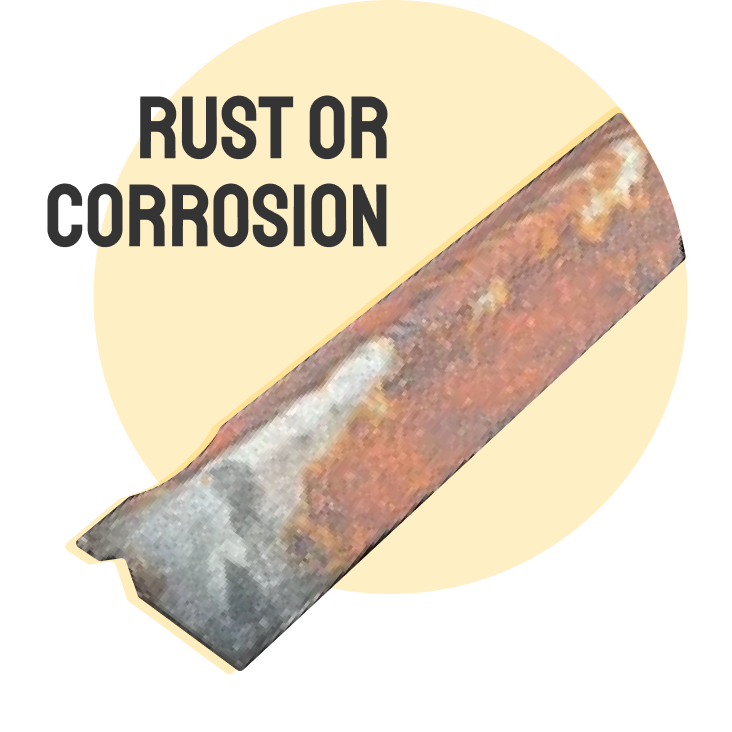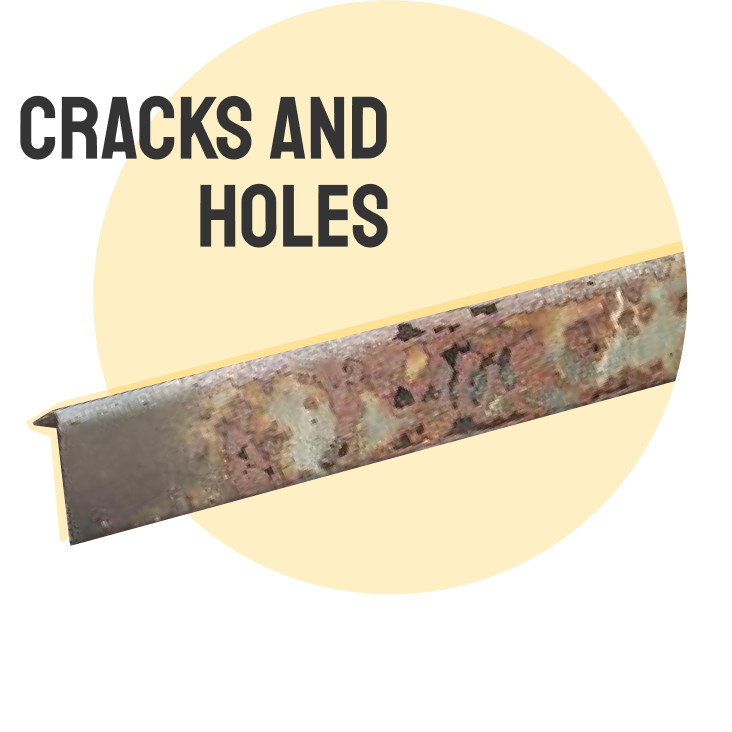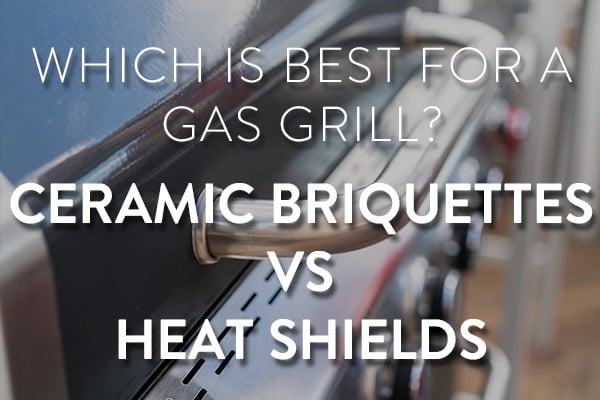
Which is Best for a Gas Grill?
Ceramic Briquettes vs Heat Shields
Whether hosting a barbecue with plenty of buddies invited or just having a bit of outdoor cooking fun on a fine day, the system you use to distribute heat across your grill’s surface is probably not the first thing on your mind. However, it can have a real impact on how much of a hit your cook-off is.
The food’s flavor, cooking time and how long it will take to clean and pack away at the end of the day can all be impacted by which heat distribution system you use.
In this article, we’re going to compare two of the most popular methods of distributing heat on a grill,
ceramic briquettes and heat shields, and see what advantages and disadvantages they have.

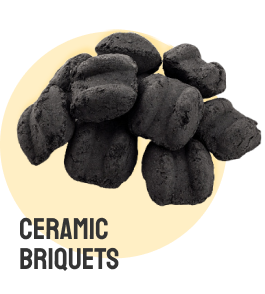
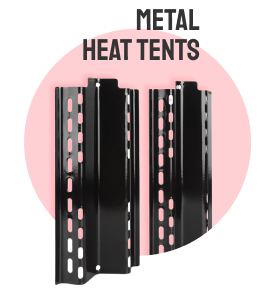
We’ll take a detailed look at how each one can change the way you grill, their costs, durability and how long they’re likely to last before they require replacing.
HOW YOU GRILL
Cost
Durability
This will hopefully give you all the information you need to help you choose the one which best fits the kind of griller you are.
Ceramic Briquettes
Ceramic briquettes are small blocks that are placed evenly across the surface of your grill.

The way they work is by absorbing heat and then radiating it evenly across the surface of your grill.
They’re becoming an increasingly popular choice for gas grill owners because of the way they are able to reach and then stay at a consistent temperature, meaning you can grill yourself evenly-cooked meat with less hassle.
Advantages of Ceramic Briquettes
There are a number of advantages ceramic briquettes have over heat shields. Let’s explore these:
Even heat distribution
Part of what has made ceramic briquettes such a popular choice is the way they evenly distribute the heat across the surface of that grill.
This helps to make evenly cooking your burgers, chops, joints or anything else a breeze.
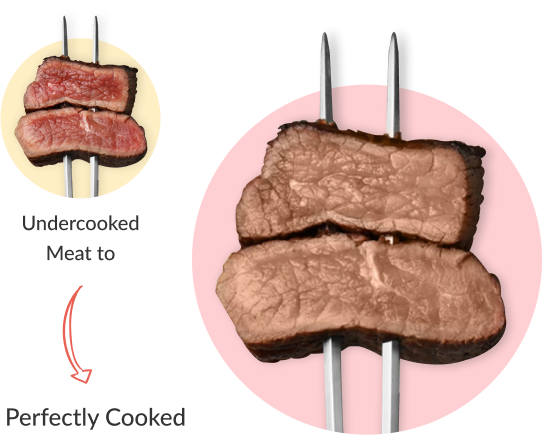
We’ve all been to barbecues where we’ve found our food isn’t thoroughly cooked, and we know how this leads to big disappointment on what should be a fun day. With ceramic briquettes, you’ll be rustling up meat that’s perfectly cooked every time.
Reduced flare-ups
Another advantage of that even heat distribution is that it reduces the number of flare-ups and hot spots on the grill.
Ever placed a succulent piece of meat on your grill only to find one spot is far hotter than anywhere else and it burns your food?
Or have you had oil from your meat drip down on to heating element, causing a big flame to rise up and char your meal?
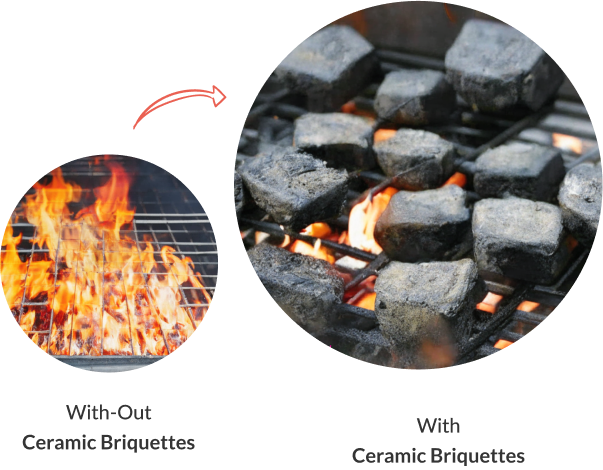
Not only is this potentially dangerous, but it’s also no good for making those burgers as delicious as you want the. Fortunately, with ceramic briquettes, those days are over. No more hot spots and no more flare-ups mean no more burned or nasty-tasting food. Ever.
Better heat retention
If you enjoy smoking food or like slow cooking, the better heat retention of ceramic briquettes has you covered.
Due to the material, they’re made from, the briquettes continue to retain and radiate heat long after you turn your gas grill’s burners off.
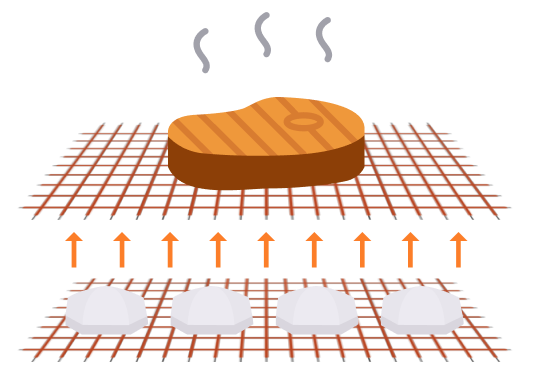
This can really open up the possibilities of what you can cook, and you’ll be able to explore a whole new world of barbecuing possibilities.
Authentic grilling experience

What also attracts barbecue fans to ceramic briquettes is that they offer a more authentic flame-grilled experience than the competition.

If you want your gas grill to produce food that has that traditional old school charred-look and smoky taste, then ceramic briquettes could be the perfect fit for you. With ceramic briquettes on your grill, you’ll be serving up real barbecued food just like we all remember from the old days.
Reusable
Something that users of this heating system really appreciate is that those little briquettes are reusable.
Once they’ve cooled down, give them a thorough clean and they’ll be good to go again next time you’re firing up the grill for a day of barbecued food. If you take good care of your briquettes, they could last up to five years. Now that’s a lot of barbecuing out of a little briquette!
Disadvantages of Ceramic Briquettes
There are a few disadvantages to consider when deciding if ceramic briquettes are right for you. They are:
How to Clean Ceramic Briquettes
When to Replace Ceramic Briquettes
There are various types of wear and tear that can happen to briquettes during their lifespan, which will make replacement necessary.
The first thing to look out for is any chips or cracks appearing on the briquette.
If you’re a frequent user of your grill, you may notice this happening to your briquettes over time as the cleaning and cooking process is what causes this damage to happened.
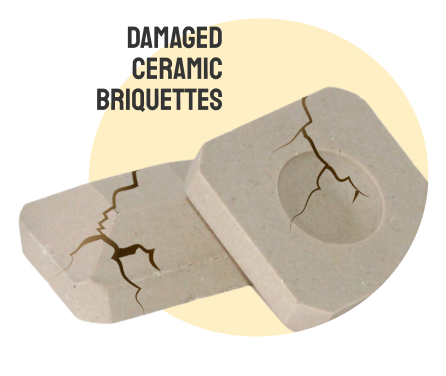
If you notice your briquettes don’t look the way they used to, consider getting them replaced. Those cracks really reduce cooking performance because the briquette is no longer able to heat evenly.
Another sign that your briquette is coming to the end of its lifespan is when you begin to notice discoloration on the surface.
New Ceramic Briquettes

Used Ceramic Briquettes

Discoloration Of Ceramic Briquettes
While the discoloration itself doesn’t reduce the capacity of the briquette to heat up properly, because that discoloration is caused by repeated exposure to heat and food debris, it’s a sign that it has had plenty of uses and it may be time to buy a new set.
While if you follow the cleaning process described earlier following each use your briquettes should last a long time, eventually, you may find that they become coated in debris that you just can’t shift. If even after a good clean and scrub that grease and other stuff won’t loosen, your briquettes’ ability to evenly absorb and radiate heat is going to be severely affected.
A big warning sign that your briquettes are past their best is when you notice that they’re unevenly heating.
If your food is no longer being prepared as perfectly as it once was, this is a sign that your briquettes are becoming worn down and producing an uneven temperature across the surface of that grill. To get cooking deliciously and thoroughly cooked food again, replace your briquettes.
Heat Shields
Heat shields are metal plates that are placed over the burners in your gas grill.

That metal surface protects the burners from any grease or anything else dripping onto them, preventing the risk of flare-ups.
They aid the grilling process by absorbing heat as it rises up from the burners. This heat then distributes across the heat shields’ metal surface as it becomes red hot and ready to cook your food. Heat shields may be made from stainless steel, cast iron or other materials. In addition to the name heat shields, they are also sometimes called heat plates and flavorizer bars.
Advantages of Heat Shields
Now let’s look at the advantages of heat shields, and why they’re a popular choice for so many grill owners:
Even heat distribution
A big plus for heat shields and why they’re so popular with many grillers is the way they evenly distribute the heat across the cooking surface.
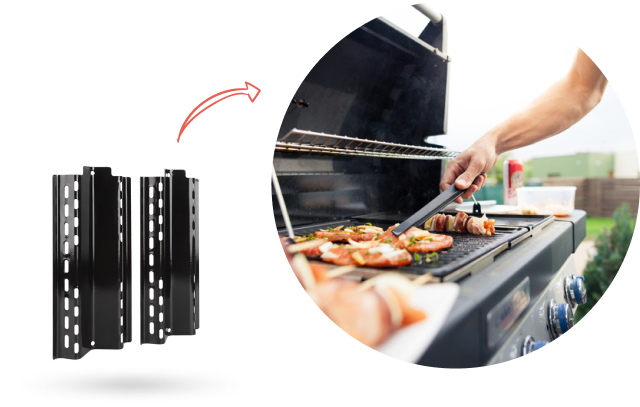
Even distribution means well and thoroughly cooked food every single time, which is exactly what you want when you’re hosting friends and family for a barbecue.
Reduced flare-ups
As your delicious meat heats, oil and grease from it can drip down. A heat shield prevents this oil and grease from falling directly onto the burners, which is how flare-ups are caused.
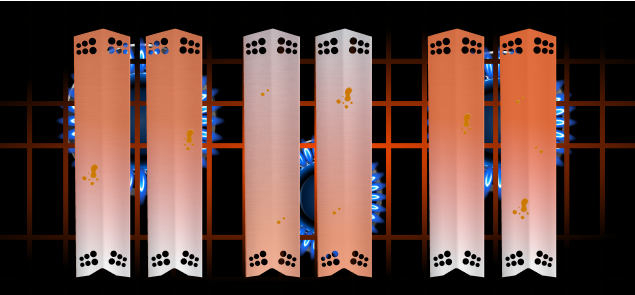
Flare-ups are a surefire way to produce singed meat that looks bad and doesn’t taste too good either. With a heat shield protecting the burners, you won’t be getting any flare-ups, which means your food is safe and will be served looking and tasting its best.
Easy to clean
Cleaning the grill after use is a necessary job, but no one really likes to do it. Fortunately, with heat shields, the entire process is a lot easier than alternatives such as ceramic briquettes.
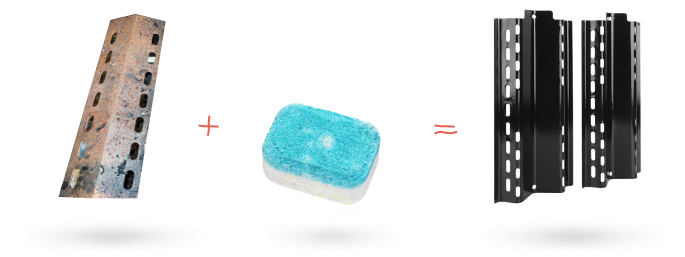
Simply remove them, give them a wipe with some soap and water and you’re done. Alternatively, just stick them in the dishwasher to get those heat shields sparkling.
Longevity
Heat shields tend to be robust and able to handle the natural bumps and knocks that are all part of the grilling and cleaning experience.
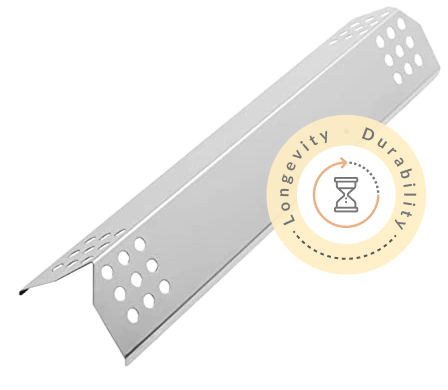
This durability means they’re a lot less likely to get damaged easily than ceramic briquettes and should be able to give you several years of service before they need replacing.
Cost-effective
Heat shields don’t have the same high initial outlay cost as ceramic briquettes.
They’re a budget option that can still give you even heat and delicious food, so if you want a proven quality grilling experience for a smaller price, a heat shield could be the way to go.
Versatility
No two grills are built the same, and fortunately, there are various differently-shaped heat shields available to suit all the different types available on the market.
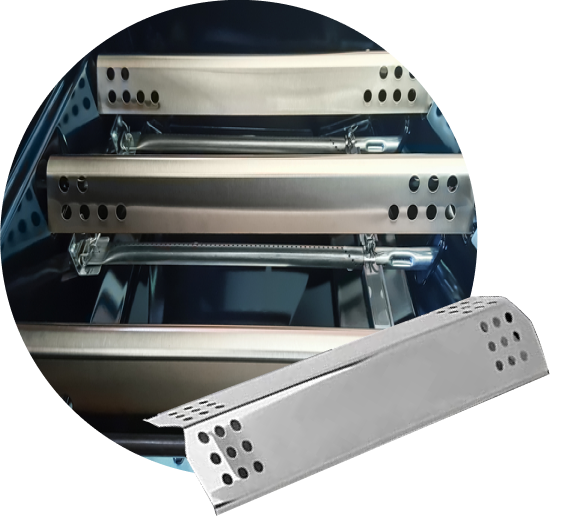
What’s more, heat shields can be built from different materials to fit your particular needs. This versatility is a big advantage and why many barbecue fans swear by their heat shield.
Disadvantages of Heat Shields
Heat shields come with a few disadvantages that you should be aware of before deciding which system to purchase. They are:
How to Clean Heat Shields
When to Replace Heat Shields
As well as when your heat shields beginning to look a bit battered and old, it’s also time to start thinking purchasing a new set when you start noticing that they don’t operate as effectively as they used to.
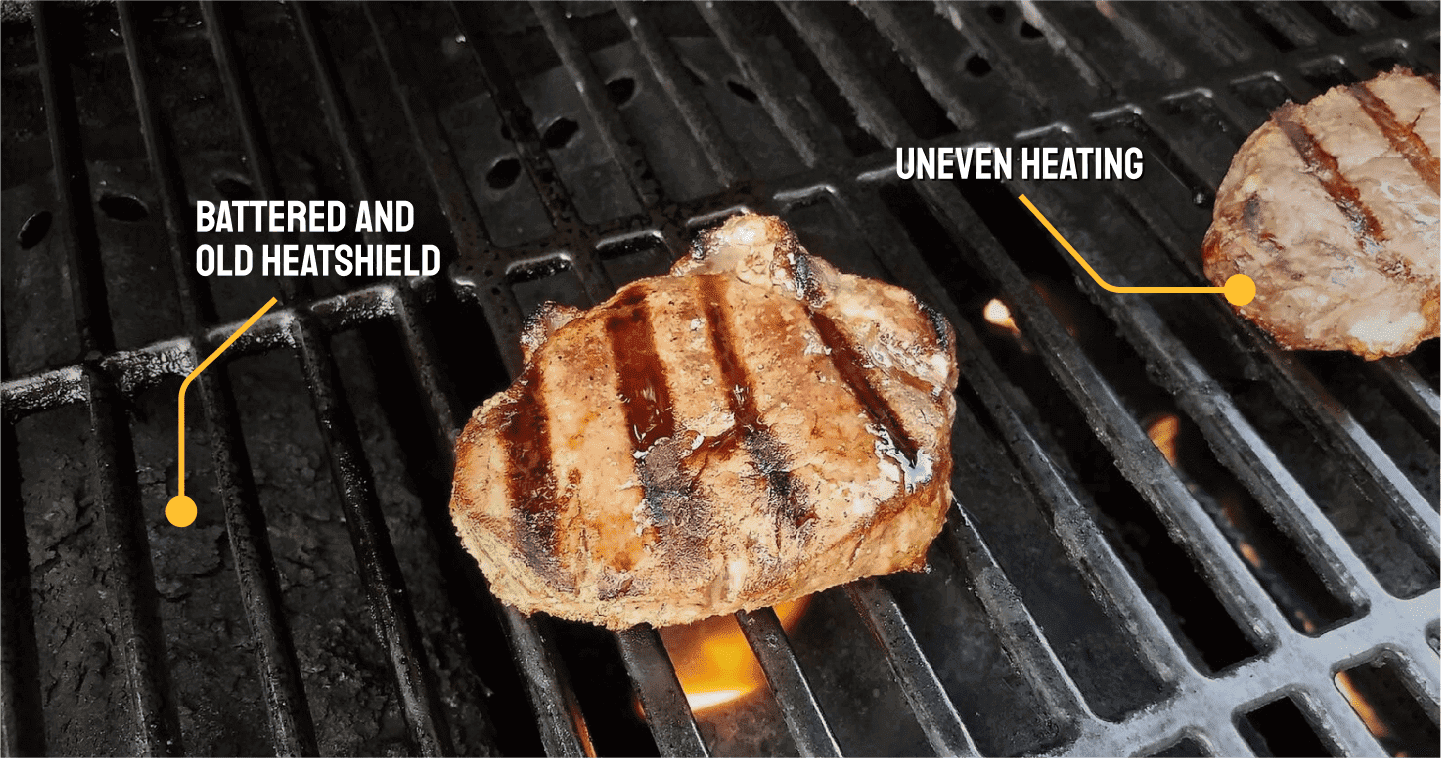
If while you’re grilling you find that certain areas just will not get hot enough to cook food, or that there’s sections where it’s singeing the surface of the food, this is a real warning that your heat shields are no longer working properly.
Tough Build-Up: Time for Replacement?
While following a thorough cleaning routine at the end of each barbecue session should keep your heat shields grease and debris-free, over an extended period of use there is going to be a build-up of really tough bits that no amount of soaking or scrubbing will get rid of.
All that debris limits performance, so when if you notice plenty on your heat shields, it could be time to get a replacement.

Comparison

Here is a comparison chart of the main differences between the two systems:
Which is Best for Your Gas Grill?

When selecting between ceramic briquettes and heat shields for your gas grill, there are a number of factors to consider.
Let’s take a look at some of the things you should think about when selecting between these two systems:
Personal preference
Ultimately, there is no right or wrong answer when it comes to choosing which is best for your grill. Both are more than effective at their job, and they both have their pros and cons.
It really does depend on how you like to use your grill, what sort of flavors you enjoy more, and how committed you are to keeping to a cleaning and maintenance routine.
So, the best advice is to use the information in this article and consider what are the priorities for you when it comes to your grill’s heat distribution system.
Grill type
The layout of some grills work better with ceramic briquettes, while for others heat shields may be more suitable.
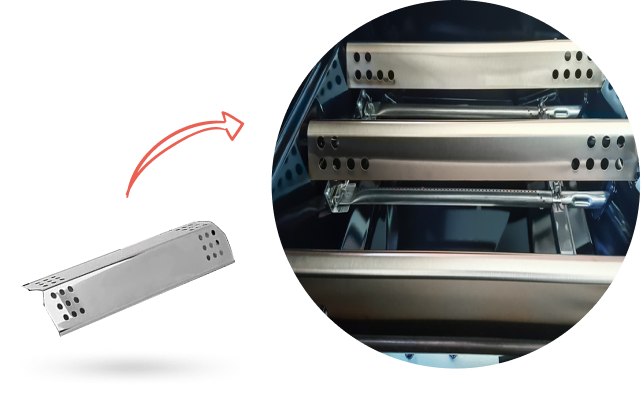
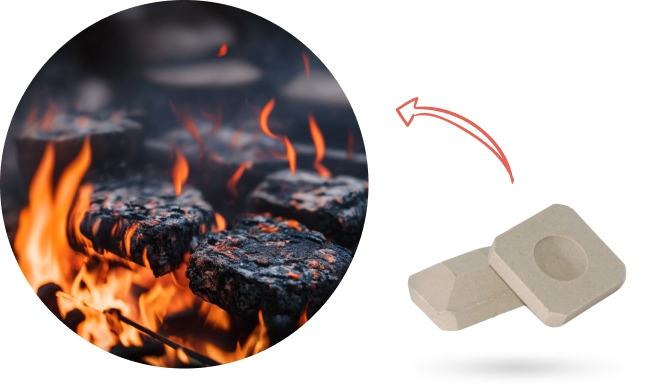
The different style of grills can impact the ease of placing and removing each type, so consult your manual or grill manufacturer to see if there’s a particular preference your grill is designed for.
Cooking style
Looking to try out slow-cooking or smoking your meats? If you are, ceramic briquettes are going to give you a far better performance than heat shields. What’s more, if you want your food to have that charred and smoky look and flavor, the best way to achieve this is with ceramic briquettes.
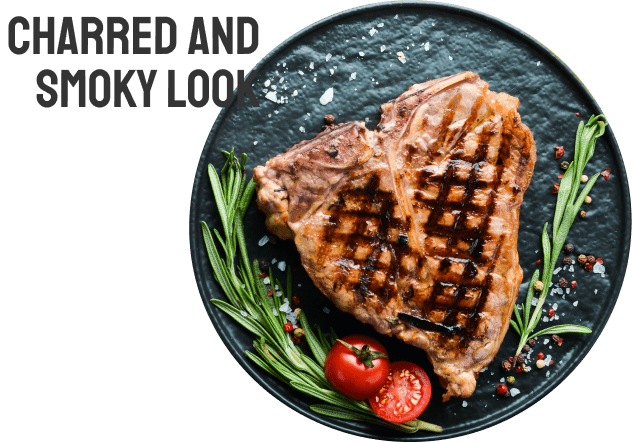
However, if you are more about enjoying the barbecue party atmosphere and want to be able to grill quickly and easily, heat shields could be for you as they require a lot less overall maintenance.
Cost
When you make your purchase, ceramic briquettes are going to cost more than heat shields. If you’re trying to be economical with your barbecuing, heat shields are your best option.
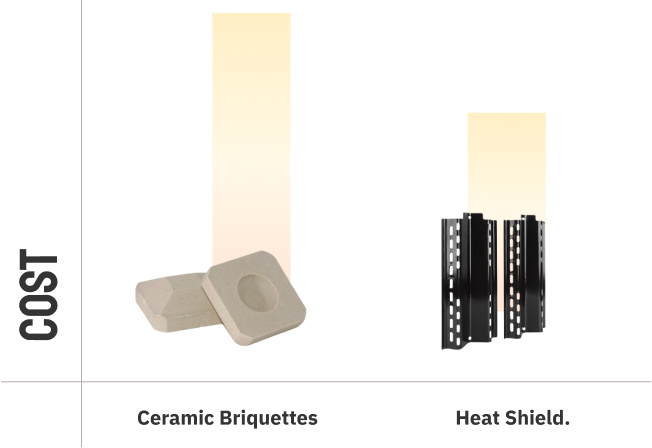
However, over time the price difference may even out, because, depending on how well you take care of your ceramic briquettes, they may outlast a heat shield.
Maintenance
Longevity
There are several factors which can impact upon the longevity of both systems, but the fragility of ceramic briquettes compared to the robustness of heat shields is something to consider.
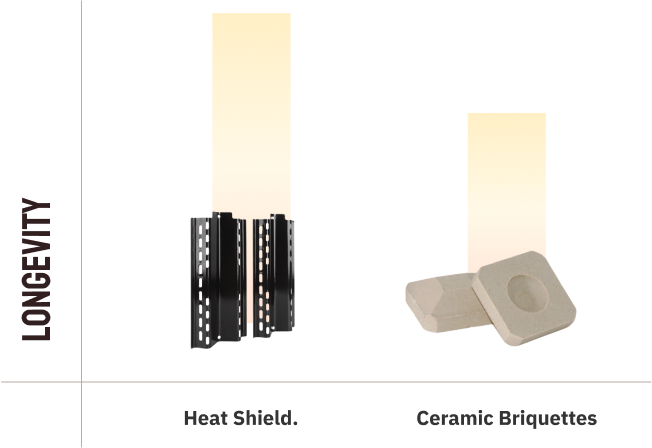
The tendency of briquettes to develop chips and cracks means they may not last as long as you require.
Availability
In some areas, one option may be more readily available than the other.
Considering that you may find on the day of your barbecue that something needs replacing urgently, having a location that’s nearby to get the replacement part you need could be a factor in your decision.
Switching From Heat Shields to Ceramic Briquettes
If you’ve decided to give ceramic briquettes a try, the process of switching over is relatively straightforward. Simply follow these steps:
Step One:
Remove the heat shields
On most grills, to remove the heat shields from the grill you simply need to unscrew or lift them out of the grill. It will be the same process you use when taking them out for cleaning.
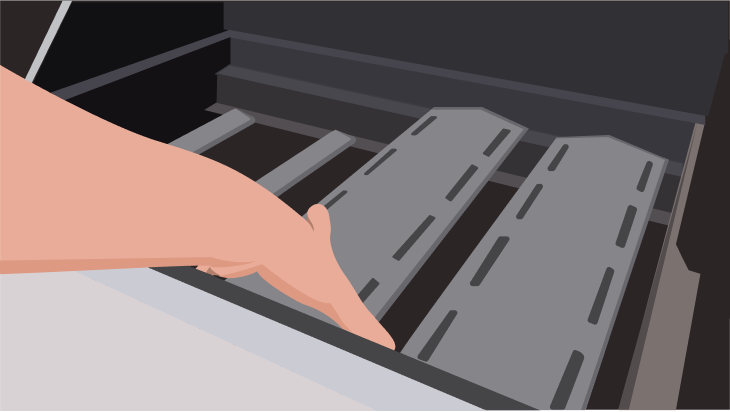
Step Two:
Install the briquette tray or rack
Your cermaic briquettes require a tray or rack to be placed on above the burner. Some grills come supplied with one, but if your didn’t you will need to purchase one at the same time you buy your set of briquettes.
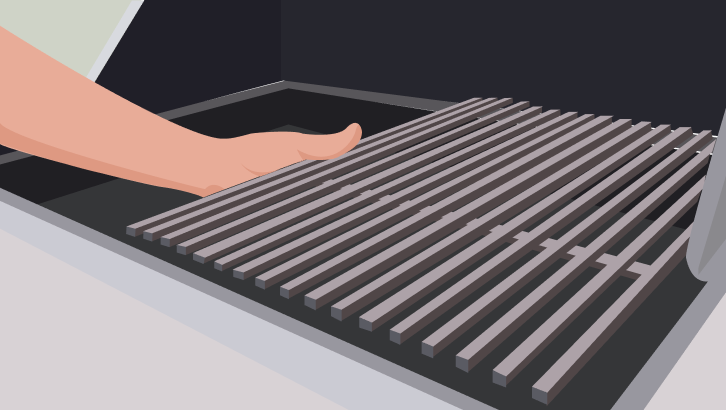
Step Three:
Add the ceramic briquettes
Place the required number of briquettes required on the rack or tray. You can find out the number of briquettes your grill requires by contacting the manufacturer.
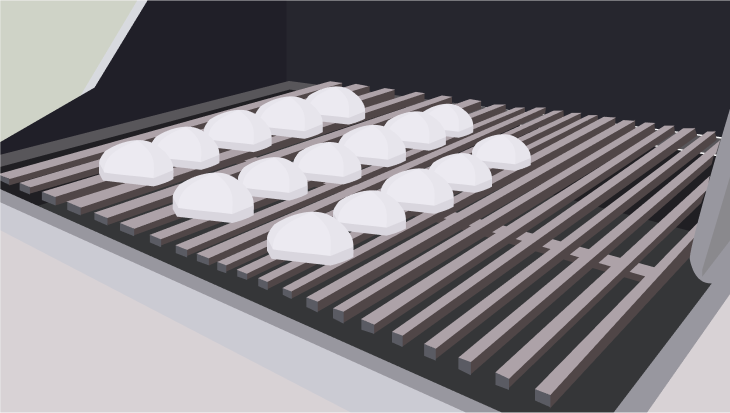
Step Four:
Adjust the burner settings
The final thing to do before firing up your grill and getting some food cooked the ceramic briquette way is to check if you need to adjust your burner settings now that you’re using a different heat distribution method. Again, this information can be found either in your grill’s manual or by contacting the manufacturer.
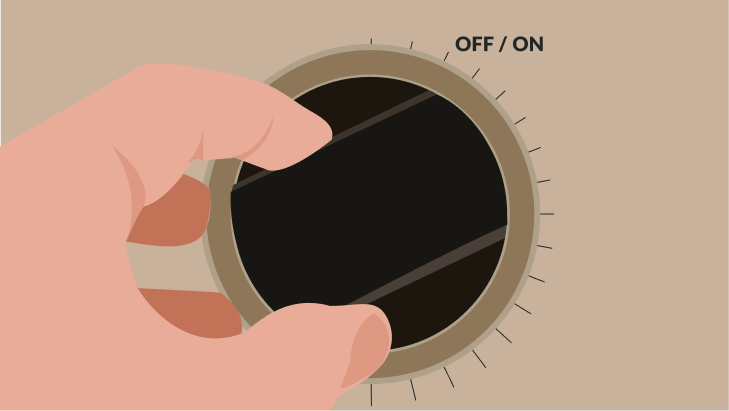
Conclusion
In this article we’ve taken a deep dive into the advantages and disadvantages of ceramic briquettes and heat shields, and hopefully, you now feel far better informed to make a better decision about which one is right for you. Overall, it comes down to personal preference and what is a priority for you when grilling. If you want that authentic flavor, ceramic briquettes are sure to deliver. However, if having a barbecue is more about quick food and having fun, you might just be more satisfied by heat shields.
Whichever you decide to purchase, happy grilling!
What benefits do ceramic briquettes and heat shields offer in terms of providing protection from excessive heat?
Gas grills utilize ceramic briquettes to distribute heat evenly while cooking. Heat shields aid in safeguarding the burners from debris and allowing the flame to directly sear the food. Ceramic briquettes can also help reduce hot and cold spots, prevent flare-ups, and minimize excess grease. Heat shields are available in aluminum or stainless steel and require periodic replacement due to discoloration over time.
Which is better for a gas grill: ceramic briquettes or heat shields?
Choosing between ceramic briquettes and heat shields depends on the results you want to achieve. Ceramic briquettes distribute heat evenly, while heat shields can create varying temperatures or protect delicate food. Consider your grilling needs before making a decision.
How do ceramic briquettes improve the effectiveness of a gas grill in terms of heat distribution, preventing flare-ups, and minimizing excess grease?
Ceramic briquettes are made of heat-resistant ceramics and are used to evenly disperse heat across the cooking surface of charcoal or gas grills. They work by drawing in hot air from the fire and spreading it out, eliminating cold spots and allowing for more efficient cooking. They also absorb fat and prevent flare-ups while keeping foods moist and juicy.
How does the use of heat shields in a gas grill help to improve the cooking experience?
Heat shields for gas grills are designed to protect the cooking grates from extreme heat, preventing food from burning. They work by absorbing and reflecting most of the heat produced before it can reach your grill’s cooking surface. Heat shields also help reduce flare-ups that can cause unwanted charring on food. With a heat shield installed, you’ll be able to cook your favorite dishes with confidence knowing they won’t burn!
What are the benefits of using ceramic briquettes?
Using ceramic briquettes when grilling is an efficient method to avoid flare-ups and ensure even heat distribution. Additionally, their composition allows them to retain more moisture, delivering more flavor and preventing your food from getting too dry while being cooked. Ceramic briquettes are long-lasting, easy to clean, and can be reused several times, making them a perfect economic choice for your grilling needs. With ceramic briquettes, you can create delicious meals with ease every time.
What are the benefits of using heat shields?
Using heat shields on your gas grill is crucial as it provides protection from high temperatures during the grilling process. Heat shields prevent food from burning and reduce flare-ups while ensuring consistent temperatures on the cooking surface. With heat shields, you can have a safe and hassle-free grilling experience, without worrying about hot spots or uneven heating, resulting in better-tasting food every time.
Are there any disadvantages to using ceramic briquettes?
Using ceramic briquettes for grilling has some drawbacks. Although they work well at regulating and concentrating heat, they can deteriorate after prolonged use, resulting in small, broken pieces that can get into your food. Furthermore, if not cleaned promptly after use, they can be challenging to clean, and they can harbor bacteria or mold growth if not dried adequately before storage. Additionally, ceramic briquettes are comparatively costly compared to alternative grill components like lava rocks or metal plates.
Are there any disadvantages to using heat shields?
Using heat shields on gas grills has several drawbacks. Firstly, they might decrease the amount of direct heat reaching the food, which could impact cooking time and temperatures required for specific dishes. Secondly, they can result in smoke and flare-ups because of fat and grease accumulation on the shield’s bottom near the burner. Moreover, if heat shields are not appropriately installed or made of low-quality materials that cannot endure high temperatures, they can pose a fire hazard in your grill.
How long do ceramic briquettes last?
Ceramic briquettes typically last up to three years before needing to be replaced. To get the most out of your ceramic briquettes, it is important to follow the instructions for proper installation and maintenance. Regularly check your grill’s temperature and replace any missing or cracked briquettes as soon as possible. If properly cared for, ceramic briquettes can provide long-lasting heat transfer in your outdoor grill.
How long do heat shields last?
Heat shields for gas grills can last anywhere from 1-3 years depending on how often you use your grill. However, it is important to check the condition of the heat shield periodically to ensure that it is not worn or corroded and should be replaced if necessary. Heat shields can become warped over time and will need to be replaced in order to keep your grill running safely and efficiently.
